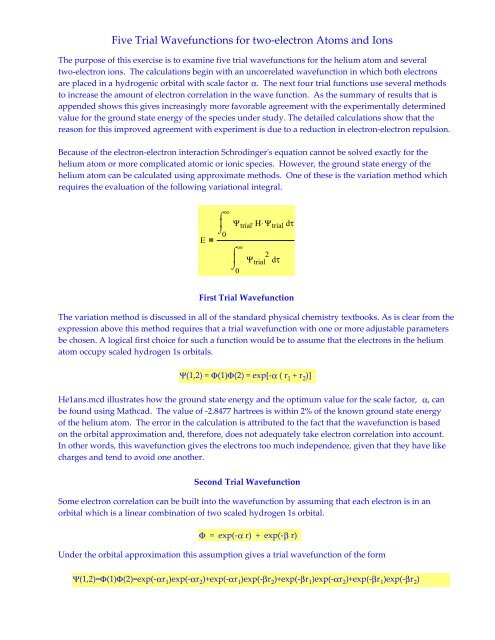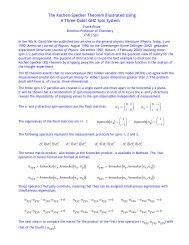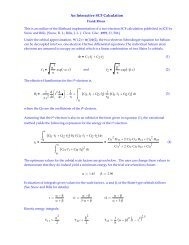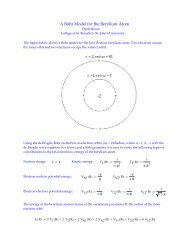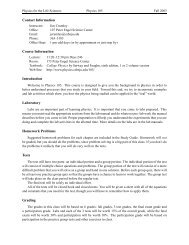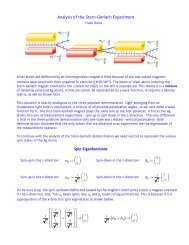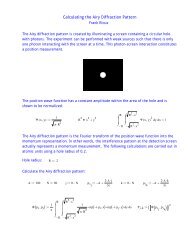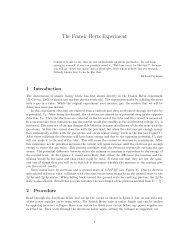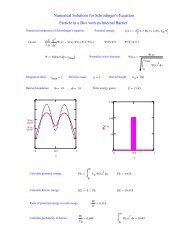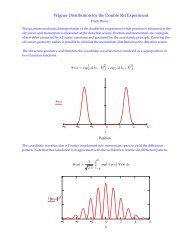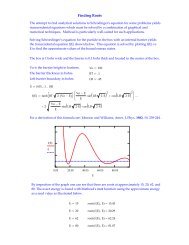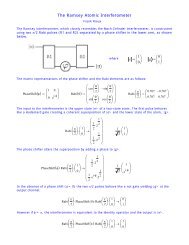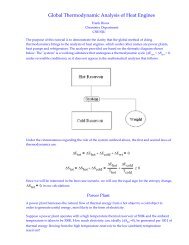Mathcad - HEATOM.mcd - Users.csbsju.edu
Mathcad - HEATOM.mcd - Users.csbsju.edu
Mathcad - HEATOM.mcd - Users.csbsju.edu
- No tags were found...
You also want an ePaper? Increase the reach of your titles
YUMPU automatically turns print PDFs into web optimized ePapers that Google loves.
Five Trial Wavefunctions for two-electron Atoms and IonsThe purpose of this exercise is to examine five trial wavefunctions for the helium atom and severaltwo-electron ions. The calculations begin with an uncorrelated wavefunction in which both electronsare placed in a hydrogenic orbital with scale factor α. The next four trial functions use several methodsto increase the amount of electron correlation in the wave function. As the summary of results that isappended shows this gives increasingly more favorable agreement with the experimentally determinedvalue for the ground state energy of the species under study. The detailed calculations show that thereason for this improved agreement with experiment is due to a r<strong>edu</strong>ction in electron-electron repulsion.Because of the electron-electron interaction Schrodinger's equation cannot be solved exactly for thehelium atom or more complicated atomic or ionic species. However, the ground state energy of thehelium atom can be calculated using approximate methods. One of these is the variation method whichrequires the evaluation of the following variational integral.E=∞⌠⎮⌡0Ψ trial ⋅Η⋅Ψ trial dτ∞⌠ 2⎮ Ψ trial dτ⌡0First Trial WavefunctionThe variation method is discussed in all of the standard physical chemistry textbooks. As is clear from theexpression above this method requires that a trial wavefunction with one or more adjustable parametersbe chosen. A logical first choice for such a function would be to assume that the electrons in the heliumatom occupy scaled hydrogen 1s orbitals.Ψ(1,2) = Φ(1)Φ(2) = exp[-α ( r 1 + r 2 )]He1ans.<strong>mcd</strong> illustrates how the ground state energy and the optimum value for the scale factor, α, canbe found using <strong>Mathcad</strong>. The value of -2.8477 hartrees is within 2% of the known ground state energyof the helium atom. The error in the calculation is attributed to the fact that the wavefunction is basedon the orbital approximation and, therefore, does not adequately take electron correlation into account.In other words, this wavefunction gives the electrons too much independence, given that they have likecharges and tend to avoid one another.Second Trial WavefunctionSome electron correlation can be built into the wavefunction by assuming that each electron is in anorbital which is a linear combination of two scaled hydrogen 1s orbital.Φ = exp(-α r) + exp(-β r)Under the orbital approximation this assumption gives a trial wavefunction of the formΨ(1,2)=Φ(1)Φ(2)=exp(-αr 1 )exp(-αr 2 )+exp(-αr 1 )exp(-βr 2 )+exp(-βr 1 )exp(-αr 2 )+exp(-βr 1 )exp(-βr 2 )
Inspection of this wavefunction indicates that 50% of the time the electrons are in different orbitals,while for the first trial wavefunction the electrons were in the same orbital 100% of the time.He2ans.<strong>mcd</strong> illustrates how this calculation would be executed. Notice the enormous increase in thecomplexity of the variational expression for the energy. However, also notice that the calculation isvery similar to that using the previous trial wavefunction. The differences are that in this case theexpression for the energy is more complex and that it is being minimized simultaneously with respect totwo parameters rather than just one. It is also clear that introducing some electron correlation into thetrial wavefunction has improved the agreement between theory and experiment.Third Trial WavefunctionThe extent of electron correlation can be increased further by eliminating the first and last term in thesecond wavefunction. This yields a wavefunction of the form,Ψ(1,2) = exp(-αr 1 )exp(-βr 2 ) + exp(-βr 1 )exp(-αr 2 )This trial wavefunction places the electrons in different scaled hydrogen 1s orbitals 100% of the time andHe3ans.<strong>mcd</strong> shows that further improvement in the agreement with the literature value of the groundstate energy is obtained. This result is within 1% of the actual ground state energy of the helium atom.Fourth Trial WavefunctionThe third trial wavefunction, however, still rests on the orbital approximation and, therefore, doesn'ttreat electron correlation adequately. Hylleraas took the calculation a step further by introducingelectron correlation directly into the wavefunction by adding a term, r 12 , involving the inter-electronseparation.Ψ(1,2) = exp[-α ( r 1 + r 2 )][1 + β r 12 ]In the trial wavefunction shown above, if the electrons are far apart r 12 is large and the magnitude of thewave function increases favoring that configuration. He4ans.<strong>mcd</strong> shows that this modification of thetrial wavefunction has further improved the agreement between theory and experiment to within 0.5%.Fifth Trial WavefunctionChandrasakar brought about further improvement by adding Hylleraas's r 12 term to the third trial wavefunction as shown here.Ψ(1,2) = [exp(-αr 1 )exp(-βr 2 ) + exp(-βr 1 )exp(-αr 2 )][1 + br 12 ]As can be seen in He5ans.<strong>mcd</strong> Chandrasakar's three parameter wavefunction gives rise to a fairlycomplicated variational expression for ground state energy. However it also gives a result for heliumthat is within .07% of the experimental value for the ground state energy. The experimental value for theground state energy of the helium atom is 2.90372 E h .The calculations that have been outlined here for the helium atom can be repeated for H - , Li + , Be ++ , etc.The hydride anion is a particularly interesting case because the first two trial wavefunctions do notpredict a stable ion. This indicates that electron correlation is an especially important issue for atomsand ions with small nuclear charge.
Summary of the Results for the Helium AtomΨ=α3 ⋅π exp ( −α⋅ r 1)⋅exp −α⋅r 2E := −2.84766( )( ) exp( α )( ) exp( β )( ) exp( α )Ψ = exp −α⋅r 1 ⋅ − ⋅r 2 + exp −α⋅r 1 ⋅ − ⋅r 2 + exp −β⋅r 1 ⋅ − ⋅r 2 + exp −β⋅r 1 ⋅E := −2.86035( ) exp( −β⋅r 2 )( ) exp( β )Ψ = exp −α⋅r 1 ⋅ − ⋅r 2 + exp −β⋅r 1 ⋅E := −2.87566( ) exp( −α⋅r 2 )Ψ = exp −αr 1 + r 2⋅( ) ⋅( + ⋅ )⎡⎣ ⎤⎦ 1 β r 12E := −2.89112( ( ) exp( β ) ( ) exp( −α⋅r 2 )) ⋅( 1 + b⋅r 12 )Ψ = exp −α⋅r 1 ⋅ − ⋅r 2 + exp −β⋅r 1 ⋅E := −2.90143Experimentally Determined Ground State EnergyE exp := −2.90372


